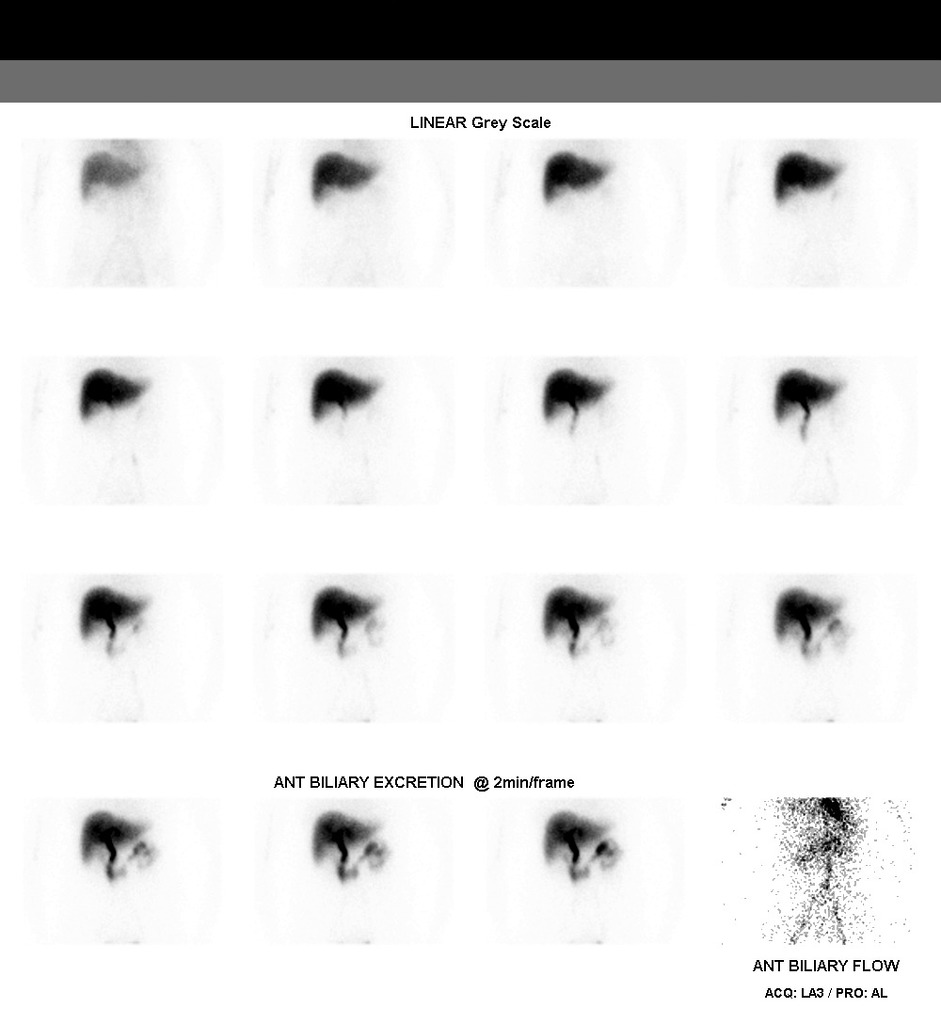Chronic cholecystitis other imaging findings
|
Chronic cholecystitis Microchapters |
|
Diagnosis |
|---|
|
Treatment |
|
Case Studies |
|
Chronic cholecystitis other imaging findings On the Web |
|
American Roentgen Ray Society Images of Chronic cholecystitis other imaging findings |
|
Risk calculators and risk factors for Chronic cholecystitis other imaging findings |
Editor-In-Chief: C. Michael Gibson, M.S., M.D. [1] ; Associate Editor(s)-in-Chief: Aditya Govindavarjhulla, M.B.B.S. [2], Furqan M M. M.B.B.S[3]
Overview
HIDA cholescintigraphy is the most sensitive and accurate modality for the diagnosis of chronic cholecystitis. HIDA cholescintigraphy findings for chronic cholecystitis include delayed gallbladder isotope accumulation, irregular gallbladder filling, or photopenic areas and septations.
Other Imaging Findings
Cholescintigraphy
HIDA cholescintigraphy findings for chronic cholecystitis include delayed gallbladder isotope accumulation, irregular gallbladder filling, or photopenic areas and septations. A gallbladder ejection fraction of less than 35% after the administration of cholecystokinin indicates the presence of the chronic calculus or chronic acalculous cholecystitis.
- Hepatobiliary scintigraphy with technetium-99m is also sensitive and accurate for diagnosis of chronic cholecystitis. It can also assess the ability of the gallbladder to expel bile (gallbladder ejection fraction), and a low gallbladder ejection fraction has been linked to chronic cholecystitis. However, since most patients with right upper quadrant pain do not have cholecystitis, primary evaluation is usually accomplished with a modality that can diagnose other causes as well. [1] [2]
- Signs of chronic cholecystitis on HIDA cholescintigraphy include delayed gallbladder isotope accumulation, irregular gallbladder filling, and septations. A gallbladder ejection fraction of less than 35% after the administration of cholecystokinin indicates the presence of chronic calculus or chronic acalculous cholecystitis.[3]
Acalculous Cholecystitis
The HIDA cholescintigraphy based diagnostic criteria from multiple studies for acalculous cholecystits is as follows.[4]
| Criteria | Diagnosis |
|---|---|
| RC MC |
Nonvisualization of the gallbladder 1 hour after injection of radiolabeled technetium ([this is radionuclide cholescintigraphy (RC)] Nonvisualization of the gallbladder 30 minutes after injection of morphine (after initial radiolabeled technetium) [this is morphine cholescintigraphy (MC)] |
Diagnosis: RC alone or RC and MC.

References
- ↑ Shea, JA, Berlin, JA, Escarce, JJ, et al. Revised estimates of diagnostic test sensitivity and specificity in suspected biliary tract disease. Arch Intern Med 1994; 154:2573.
- ↑ Fink-Bennett, D, Freitas, JE, Ripley, SD, Bree, RL. The sensitivity of hepatobiliary imaging and real time ultrasonography in the detection of acute cholecystitis. Arch Surg 1985; 120:904.
- ↑ Chamarthy, M.; Freeman, LM. (2010). "Hepatobiliary scan findings in chronic cholecystitis". Clin Nucl Med. 35 (4): 244–51. doi:10.1097/RLU.0b013e3181d18ef5. PMID 20305411. Unknown parameter
|month=ignored (help) - ↑ Huffman, JL.; Schenker, S. (2010). "Acute acalculous cholecystitis: a review". Clin Gastroenterol Hepatol. 8 (1): 15–22. doi:10.1016/j.cgh.2009.08.034. PMID 19747982. Unknown parameter
|month=ignored (help)